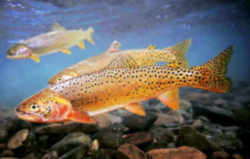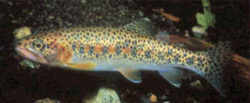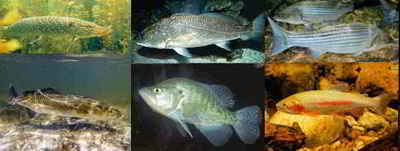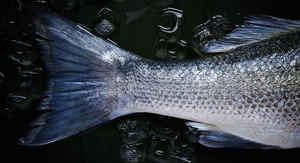
Utah Symbols
Utah State Fish
Bonneville Cutthroat Trout

(Salmo clarki)
to
(Oncorhynchus clarki utah)
Adopted in 1977.
The Cutthroat Trout, (Oncorhynchus clarki utah,) was adopted in 1977 as Utah's state fish. The cutthroat trout has 15 recognized subspecies, one of which is the Bonneville Cutthroat. Senate Bill 236, in the 1997 Legislature, adopted the Bonneville Cutthroat as the state fish after having the Rainbow Trout since 1971. The Bonneville Cutthroat is native to Utah and was important to the Indians and the Mormon pioneers as a source of food. There are some that speculate the pioneers were saved from starvation many times by catching and eating fish but claim it wasn't necessarily the trout that they ate but carp.
Utah State Fish: Bonneville Cutthroat Trout
 The
Bonneville cutthroat trout (Oncorhynchus clarki utah) is a subspecies of cutthroat trout native to tributaries of the Great Salt Lake, U.S.A. Most
of the fish's current and historic range is in Utah, but they are also found in Idaho, Wyoming, and Nevada. This is one of 14 or so recognized subspecies
of cutthroat trout native to the western United States.
The
Bonneville cutthroat trout (Oncorhynchus clarki utah) is a subspecies of cutthroat trout native to tributaries of the Great Salt Lake, U.S.A. Most
of the fish's current and historic range is in Utah, but they are also found in Idaho, Wyoming, and Nevada. This is one of 14 or so recognized subspecies
of cutthroat trout native to the western United States.
Characteristics of the Bonneville Cutthroat Trout
All cutthroat trout have a "cut," a patch of orange or red on the throat and they differ from the rainbow trout because they have basibranchial (hyoid) teeth in their throat between the gill arches, they typically have longer heads and jaws than the rainbow and often times can be distinguished from the rainbow by their larger spots. The cutthroat is known to be more vulnerable to anglers because of a general lack of wariness and can be caught on a wide variety of bait.
Bonneville cutthroat trout primarily eat other fish, while smaller individuals and to a lesser extent adults consume a lot of insects and various benthic organisms. They spawn near the mouths of streams over gravel substrate in the springtime, having an incubation period of 24 to 25 days
Habitat
Bonneville cutthroats were once widespread in all major streams on the east side of what is now Great Basin National Park, in east-central Nevada (which in turn borders Utah on the west). However, they were severely reduced by introduced trout species, water diversions, and other human activities. In fact, most streams within the park are no longer inhabited by Bonneville cutthroats.
History

It is named for Lake Bonneville, which occupied much of western Utah during the Ice Age. As the climate became warmer and drier, Lake Bonneville shrank drastically. Today, the largest souvenir of this ancient lake is Utah's Great Salt Lake, the largest body of water between the Great Lakes and the Pacific Ocean and the largest salt lake in the western hemisphere. Since ancient Lake Bonneville dried up 8,000 years ago in what is now eastern Nevada and Utah, Bonneville cutthroat trout, (Oncorhynchus clarki utah,) have persisted in the isolated small mountain streams of the eastern Great Basin. Unfortunately, water diversions, subsistence harvest, and especially stocking with nonnative fish caused the extirpation of the Bonneville cutthroat trout from most of its range. The local extinction was so widespread that the US Fish and Wildlife Service is now conducting a second status review for listing the trout under the Endangered Species Act of 1973. However, Great Basin National Park near Baker, Nevada, on the Nevada-Utah border provided a unique opportunity to promote conservation of the trout and potentially preclude the need for listing it in eastern Nevada.The Bonneville cutthroat trout was believed to be extinct in Great Basin National Park because past surveys revealed only nonnative hatchery fish or hybrids of the Bonneville cutthroat and rainbow trout (O. mykiss). After the park established a reintroduction program for the trout in 1998, a survey in one stream system of the park in 2000 revealed only fish with strong characteristics of the Bonneville cutthroat trout. Subsequent genetic analysis of fin tissues confirmed the presence of a pure population of the species. The timely discovery of the trout was fortunate because cleansing of the stream system with chemicals to remove the nonnative trout and the hybrids that were thought to be there was planned as the next step in the reintroduction program. Instead of being inadvertently annihilated, the population is now being genetically compared with other populations of the Bonneville cutthroat trout in nearby streams. If appropriate, the preservation of the genetic stock that developed in the park will be attempted. With discovery of this population, a source stock became available for reintroductions elsewhere in the park. The park established a new population of Bonneville cutthroat trout in a stream of another watershed by transplanting 60 trout from the source stock. Another historical Bonneville cutthroat trout stream has been chemically cleansed to remove the nonnative fish and hybrids in preparation for a reintroduction of Bonneville cutthroat trout in 2001. Private landowners adjacent to the park supported a more diversified fishery and allowed chemical cleansing of streams on their lands. The extension of cleansing beyond park boundaries may facilitate restoration of a native fishery throughout an entire watershed.
Utah SB 236
S.B. 236 Enrolled
STATE FISH AMENDMENTS
1997 GENERAL SESSION
STATE OF UTAH
Sponsor: Pete Suazo
AN ACT RELATING TO STATE FISH; DESIGNATING THE BONNEVILLE CUTTHROAT
AS THE STATE FISH.
This act affects sections of Utah Code Annotated 1953 as follows:
AMENDS:
63-13-7.3, as enacted by Chapter 161, Laws of Utah 1971
Be it enacted by the Legislature of the state of Utah:
Section 1. Section 63-13-7.3 is amended to read:
63-13-7.3. State fish.
The [rainbow] Bonneville cutthroat trout is hereby selected and designated to be the state fish of Utah.
Utah Law
The law designating the[rainbow] Bonneville cutthroat trout as the official Utah state fish is Section S63-13-5.5 ( State symbols of the
Utah Code) Title 63 (General Government) Chapter 13 (MISCELLANEOUS PROVISIONS)
Section 63-13-5.5. All of Utah's state symbols are listed in section 63-13-5.5. Below, we have only listed the entry regarding the official state fish.
Title 63 - General Government
CHAPTER 13 - MISCELLANEOUS PROVISIONS.
SECTION 63-13-5.5.
63-13-5.5. State symbols. ...(10) Utah's state fish is the Bonneville cutthroat trout ....
Amended by Chapter 152, 2003 General Session
Taxonomic Hierarchy: Bonneville Cutthroat Trout
Kingdom: Animalia - animals
Phylum: Chordata
Class: Osteichthyes
Order: Salmoniformes
Family: Salmonidae
Genus: Oncorhynchus
Species: (Salmo clarki) to (Oncorhynchus clarki utah)







